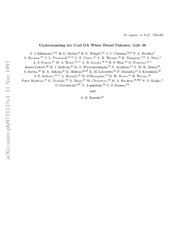Understanding the Cool DA White Dwarf Pulsator, G29–38
Permanent lenke
https://hdl.handle.net/10037/2038Dato
1997-10-10Type
Journal articleTidsskriftartikkel
Peer reviewed
Forfatter
Solheim, Jan Erik; Kleinman, S. J.; Bruvold, A.; Nather, R. E.; Winget, D. E.; Clemens, J. C.; Bradley, A.; Kanaan, A.; Claver, C. F.; Watson, T. K.; Yanagida, K.; Nitta, A.; Dixson, J. S.; Grauer, A. D.; Hine, B. P.; Fontaine, G.; Liebert, James; Sullivan, D. J.; Wickramasinghe, D. T.; Achilleos, N.; Mara, T. M. K.; Seetha, S.; Ashoka, B. N.; Leibowitz, E. M.; Moskalik, P.; Krzesi´nski, J.; O’Donoghue, D.; Kurtz, D. W.; Warner, B.; Martinez, Peter; Dolez, N.; Chevreton, M.; Barstow, M. A.; Kepler, S. O.; Giovannini, O.; Hansen, C. J.; Augusteijn, T.Sammendrag
The white dwarfs are promising laboratories for the study of cosmochronology
and stellar evolution. Through observations of the pulsating white dwarfs, we can
measure their internal structures and compositions, critical to understanding post main
sequence evolution, along with their cooling rates, allowing us to calibrate their ages
directly. The most important set of white dwarf variables to measure are the oldest
of the pulsators, the cool DAVs, which have not previously been explored through
asteroseismology due to their complexity and instability. Through a time-series
photometry data set spanning ten years, we explore the pulsation spectrum of the
cool DAV, G29–38 and find an underlying structure of 19 (not including multiplet
components) normal-mode, probably ℓ = 1 pulsations amidst an abundance of time
variability and linear combination modes. Modelling results are incomplete, but
we suggest possible starting directions and discuss probable values for the stellar
mass and hydrogen layer size. For the first time, we have made sense out of the
complicated power spectra of a large-amplitude DA pulsator. We have shown its
seemingly erratic set of observed frequencies can be understood in terms of a recurring
set of normal-mode pulsations and their linear combinations. With this result, we
have opened the interior secrets of the DAVs to future asteroseismological modelling,
thereby joining the rest of the known white dwarf pulsators.
Beskrivelse
This is the authors' accepted version of the article.
Forlag
The American Astronomical SocietySitering
The Astrophysical Journal, 495:424-434, 1998 March 1Metadata
Vis full innførselSamlinger
Følgende lisensfil er knyttet til denne innførselen:


 English
English norsk
norsk